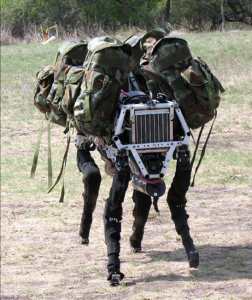At 70 robot dog years-old – that’s 10 in human years – BigDog should’ve had a few more years of happily serving his masters ahead of him. Instead, the US Marines have pulled an Old Yeller on the unsuspecting robocanine, sending him to an early grave, or junkyard as the case may be.
Created in 2005, BigDog was the result of a collaborative effort between robotics design company Boston Dynamics, the NASA Jet Propulsion Laboratory (JPL), and researchers at Harvard University. Funding for BigDog came from the always forward-thinking Defense Advanced Research Projects Agency (DARPA) with development guidance and testing handled by the Marine Corps Warfighting Lab.
At 3 feet long and standing 2.5 feet tall, BigDog appears aptly named at first glance, but its creator’s envisioned its role as more of a pack animal than a mechanical canine companion. SmallMule just didn’t roll off the tongue as well, so the BigDog moniker stuck. Powered by a one-cylinder, two-stroke go cart engine, BigDog was meant to walk, run and climb over rough terrain all while carrying loads of up to 340 pounds.
Locomotion, navigation and path planning, balance, and other goal-focused behavior were assisted by a large collection of sensors including stereo vision, LIDAR, and gyroscopes to name a few. Sensor data was then fed to the BigDog’s brain: a PC/104 stack with a Pentium CPU running QNX. A custom set of hydraulic actuators converted thought into action as the BigDog lumbered on its way.
As revisions were made, its official name has changed over the years, from AlphaDog in 2010 to the more official sounding Legged Squad Support System (LS3) in 2012. Regardless of what it was called on paper, the BigDog name stuck with it until the end.
And what of its end? By most accounts, BigDog was good at its job. It could run a speeds of up to 4 MPH. It could haul heavy loads through water, snow, and mud and climb slopes as steep as 35 degrees. So why did the Warfighting Lab announce that BigDog would not ever be appropriate for deployment and as a result, terminate the project?
I knew immediately why without reading the reason, and if you’ve ever seen one in person, or watched videos of the BigDog in action on YouTube, then I bet you can probably guess it too … Yup, the BigDog is loud as shit and has not been getting any quieter. Apparently the advantage of having a machine to carry their gear was outweighed by the fact that it sounded like a riding lawn mower, easily giving away their position to even the most technologically unsophisticated enemy.
The following video is of the LS3, the most recent BigDog iteration. It is pretty impressive to watch .. with the volume off. Turn on the volume, and you’ll discover why the Marines don’t want to be within several clicks of one of these in the field.
To be fair, they also cited field maintenance concerns as another reason for scuttling the project. It seems to me like this was just thrown in so that the engineer who decided it was a good idea to use a go cart motor didn’t feel like BigDog’s failure was entire his fault. But of course it was.
RIP BigDog. You were both the stuff of dreams and nightmares.
You can read more about the death of BigDog and the future of military robots at military.com.

